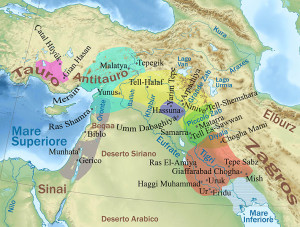Read about the age of J2-M172 etc. here: Age Estimates.
These prehistoric cultures are likely vectors of the early J2 diversification, migration and expansion in the Fertile Crescent, Middle East and beyond. BC = before common era, BP (before present) = BC + present year:
- Baradostian 36,000 – 18,000 BC Zagros
- Zarzian 18,000 – 8,000 BC Zagros
- Ubaid 6,500 – 3,800 BC Mesopotamia
- Halaf, Hassuna 6,100 – 5,500 BC Northern Fertile Crescent, Mesopotamia
- Shulaveri-Shomu(tepe) 6000-4100 BC Caucasus/Armenia
- Samarra 5,500 – 4,800 BC Upper Mesopotamia
- Sumer 5,500 – 4,000 BC Lower Mesopotamia
- Leyla-Tepe (Leilatepe) 4350-4000 BC Caucasus
- Uruk 4,000 – 3,100 BC Mesopotamia
- Kura–Araxes 3,400 – 2,000 BC Caucasus/Armenia
- Indus Valley (Harappan) Civilization 3,300 – 1,300 BC Pakistan/India
- Elam 3,200 – 539 BC South Zagros/Iran
- Minoan 2,700 – 1,500 BC Crete, Greek Islands
- Jiroft 2,500 – 2,200 BC East Iran
- Assyria 2,500 BC – 605 BC Upper Mesopotamia
- Canaanite 2,500 – 1,000 BC Levant
- Kulli 2,500 – 2,000 BC Balochistan (Gedrosia)
- Amorites 2,400 – 1,200 BC Syria
- Hattians 2,300 – 1,700 BC Central Anatolia
- Hurrian 2,300 – 1,200 BC Upper Mesopotamia
- Bactria–Margiana Arch. Complex (BMAC, Oxus civilization) 2300–1700 BC Hindukush
- Babylonia 1,894 – 911 BC Central-Southern Mesopotamia
- Yamhad/Halab 1810-1517 BC Northwestern Fertile Crescent bordering to Qatna in the South (North of Canaan) and Mari in the Southwest
- Hittites 1,600 – 1178 BC Anatolia
- Mitanni 1,500 – 1,300 BC Northern Fertile Crescent
- Hayasa-Azzi 1500 – 1290 BC Armenian Highlands
- Israelites 1500 – 600 BC Levant
- Phoenicia 1,200 – 539 BC Levant
Classical Antiquity – Early Middle Ages
Cultures in the classical antiquity where likely a mix of earlier cultures/populations (and therefore Haplopgroups). Only a few comprehensive modern Y-DNA studies (high-res STRs and/or SNPs) of populations of Middle East and North-Eastern Mediterranean exist as well as a lack of ancient Y-DNA studies from the same area. Therefore it is very difficult to reconstruct the ancient haplogroup distribution and origin of lineages. The following information is taken mostly from Wikipedia.
- Neo-Assyrian Empire (911 – 612 BC): After the Bronze Age collapse, with great upheavals and mass movements of people, Assyria assumed a position as the most powerful state on earth, successfully eclipsing Babylonia, Egypt, Urartu/Armenia, Elam, Phrygia, Persia and Media for dominance of the Near East, Asia Minor, Caucasus, North Africa and east Mediterranean, though not until the reforms of Tiglath-Pileser III in the 8th century BC did it become a vast empire. During this period, Aramaic was made official language of the empire, alongside the old Akkadian language. The rulers had a strong tradition of enslaving and deporting conquered populations to other parts of the Assyrian empire, among them Arameans, Neo-Hittites, Hurrians, Israelites, Samaritans, Sidonians, sdsd sdsd
- Late Israelites / early Jews (700 BC – 70 CE): there are some interesting statements as from archaeologist Jonathan N. Tubb, “Ammonites, Moabites, Israelites and Phoenicians undoubtedly achieved their own cultural identities, and yet ethnically they were all Canaanites”. And from Mark Smith: “Israelite culture largely overlapped with and derived from Canaanite culture… In short, Israelite culture was largely Canaanite in nature.”.
Looking at the percentage of haplogroups for men with deep ancestry in the Southwestern Fertile Crescent, the mixup could represent the more northern Canaanites (J2a, maybe related to Hyksos, Jews living in the northern Kingdom of Israel / Samaria), the more southern nomadic tribes known as “Hebrews” (J1, also defined as Jews living in the southern Kingdom of Judea), input from Egypt (E1b, maybe also by the return of Hyksos people) and other typical Middle East haplogroups (G, L, T) and some late arrivals (R1b, R1a).
Trough the heavy diaspora it is unclear how many of the modern Jewish Y-DNA lineages go back to Isrealite/Judea territory and time, as even early Jews could have converted before (biblical term proselyte) from other nearby populations and cultures, embracing the first major monotheistic religion and leaving behind ancient Semitic religions.
Kohen Jewish priests are traditionally believed and required to be of direct patrilineal descent from the biblical Aaron. Low-res Y-STR research (1997/1998) was interpreted so that a majority of present-day Jewish Kohanim share a “Cohen Modal Haplotype (CMH)” and therefore descend from the “Y-chromosomal Aaron“. More recent research (2009) found proof for multiple contemporary Jewish Kohanim lineages, with ca. 46% J1-P58 and ca. 15% J2a-M410 (matching to L24-PF5366 subgroup) sharing the low-res CMH as well as other haplogroups. Non-Kohanim and non-Jewish populations carry also the CMH. Therefore the old CMH is no reliable prediction of origin.
- Phoenicia / Carthage (800 – 146 BC): expansion from Levantine ports, leading to domination of trade in the Mediterranean. Carthage was founded in 814 BC and had dependencies in North Africa, Sicily, Italy, Sardinia and southern Spain. Some studies link J2a-lineages to this expansion period, but the resolution is too low for good conclusions and distinction of those lineages.
- Ancient Greeks (700 – 150 BC): likely J2a was further dispersed from Greeko-Anatolian shores and islands in to the Mediterranean; it is still very present in Crete. J2b2a1-L283 was likely to be present in mainland ancient Greece as still having high distributions especially in Illyria and Macedonia territory. It is unclear where J2b2a-M241also present in Western and South Asia originated.
- Etruscans (700 – 100 BC): modern mtDNA (2007) seems to indicate a local origin vs. the Anatolian theory. Unfortunately no comprehensive high-res Y-DNA study is available to analyze this further and to possibly exclude substantial J2 migration trough this culture.
- Neo-Babylonian Empire and Chaldea (626 – 539 BC): In alliance with the Medes, Assyria was defeated and the seat of empire was again transferred to Babylonia. This period witnessed a general improvement in economic life and agricultural production, and a great flourishing of architectural projects, the arts and science.
The Neo-Babylonian period ended with the reign of Nabonidus in 539 BC. To the east, the Persians had been growing in strength, and eventually Cyrus the Great established his dominion over Babylon. - Achaemenid (Persian) Empire (550 – 330 BC): founded by Cyrus the Great in Iran, the empire expanded to eventually rule over significant portions of the ancient world, which at around 500 BC stretched from parts of the Balkans (Bulgaria–Pannonia) and Thrace–Macedonia in the west, to the Indus Valley in the east, making it the largest empire the world had yet seen.The Empire would eventually control Egypt as well. It was ruled by a series of monarchs who unified its disparate tribes and nationalities by constructing a complex network of roads. It is easy to imagine a major east/west expansion and dispersion of both J2a and J2b lineages (as well as R1a) in this time.
- Seleucid Empire (312 BC – 63 BC): was a Hellenistic state ruled by the Seleucid dynasty following the division of the greek empire created by Alexander the Great. Seleucus received Babylonia and, from there, expanded his dominions to include much of Alexander’s near eastern territories. At the height of its power, it included central Anatolia, Persia, the Levant, Mesopotamia, Kuwait, what is now Pakistan, Afghanistan, Turkmenistan, and northwest parts of India.
- Parthian Empire (247 BC – 224 CE): At its height, the political and cultural power in ancient Persia stretched from the northern reaches of the Euphrates, in what is now central-eastern Turkey, to eastern Iran. The empire, located on the Silk Road trade route between the Roman Empire in the Mediterranean Basin and the Han Empire of China, became a center of trade and commerce. For about the first half of its existence, the Arsacid court adopted elements of Greek culture, though it eventually saw a gradual revival of Iranian traditions.
- Roman Empire (150 BC – 400 CE): very likely this era imported most of the modern European J2a, especially to Northwestern Europe. Probably also J2b expanded out of the Balkan to Western Europe mainly in this period. The migration was probably driven by commerce, trade, military movements and (re)settling of free land.
- Rabbinic Judaism (70 CE – ): gained predominance within the Jewish diaspora between the 2nd to 6th centuries. Like for early Jews it is unclear if and how many J2 lineages converted to Judaism starting with this period and how much this reformed Judaism contributed to the founding and establishing of Jewish communities like Mizrahi, Italian Jews, Sephardic and Ashkenazi in the Middle East and Europe.
- Judeo / Early Christianity (100 CE – ): the rapid spread and expansion of the religion based on Jesus of Nazareth mainly to Europe evolved from persecutions to toleration (313) and to state church of the Roman Empire (380) and following kingdoms. No significant migration out of the Middle East driven by Christian expansion is known, probably because the faith spread heavily by conversion from pagan populations. In later centuries Christianity persecuted minorities like the Jews in Western Europe and many were forced to convert (Crypto-Jews, Hidden Jews).
- Sassanid Empire (224 – 651 CE): this Iranian empire was recognized as one of the main powers in Western and Central Asia, alongside the Roman–Byzantine Empire, for a period of more than 400 years. At its greatest extent, the Sassanid Empire encompassed all of today’s Iran, Iraq, Eastern Arabia (Bahrain, Kuwait, Oman, Qatif, Qatar, UAE), the Levant (Syria, Lebanon, Israel, Jordan), the Caucasus (Armenia, Georgia, Azerbaijan, Dagestan, South Ossetia, Abkhazia), Egypt, large parts of Turkey, much of Central Asia (Afghanistan, Turkmenistan, Uzbekistan, Tajikistan), Yemen and Pakistan.
- Islamic conquests (623 – 1050 CE): Muslim power out of Arabia in a few centuries dominated the Middle East reaching to the West into Spain and to the East to the borders of India and China. Probably this time led to the great changes of populations trough migration in the area under control (similar to the migration period in Europe 376-800). However it is very difficult to reconstruct which J2 lineages find their expansion in this time and not before in the many great empires.
Thoughts about claimed deep paternal ancestry
Traditional as well as claimed genealogical deep ancestry (over 20 generations) of widely distributed lineages needs extensive testing and comprehensive proof both by genetics and historical sources. The most prominent claimed ancestors for J2 lineages are Cohen priest ancestry, Roman and Arabic conqueror ancestry and similar ancient positions of respect and/or power. Often the wish is father to the claim. Consider this:
- Male lineages died out, a men from another lineage married a daughter and adopted the rank/name (similar to king lineages, see UK etc.)
- Most of high ranking men could have been killed during sieges and conquests. Later maybe different lineages restored and took the position/function.
- Similar to 2) rulers could have eliminated high ranking unpleasant men and installed loyal companions.
All successors in the cases 1) 2) 3) have the greatest interest to still claim the traditional progenitor as their (direct paternal) ancestor.


